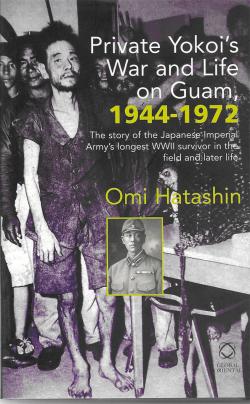Private Yokoi’s War and Life on Guam, 1944-1972

The Story of the Japanese Imperial Arm’s Longest WWII Survivor in the Field and Later Life, by Omi Hatashin, Global Oriental, 2009, 237 pages including index and a black and white plate section, ISBN 978-1-905246-69-4
Review by Sir Hugh Cortazzi
This is an extraordinary story of hardship and fortitude. “His faith in the Japanese Emperor and his hope of the Japanese Empire’s final victory were formidable, but they turned out to be utterly hollow…He did not completely lose his last traces of humanity even when he was reduced to the habits of a wild animal in order to survive in the Guam jungle. He humorously said back in Japan to young children that he was simply good at ‘hide and seek’ (page 215).” After his return to Japan he insisted on putting up a memorial in Guam to the animals he had killed in order to survive.
Private Yokoi, a tailor by trade, was sent to Guam in March 1944. When American forces invaded the island and annihilated the Japanese defence forces. Yokoi and his section took to the jungle. They dismissed American calls to surrender and assertions about Japan’s defeat as deceitful enemy propaganda. Eventually Yokoi and two other soldiers who had survived American attacks banded together, scavenged for food and lived rough in the jungle. Not surprisingly in the circumstances there was friction and Yokoi came to live largely on his own. However the three came together from time to time. In 1963 they climbed the main mountain on the island in the hope that they could somehow see a way to escape from the island, but they soon realised that this would be impossible. His two companions became sick and in 1964 died in their underground shelter. Yokoi managed to hang on despite stomach ulcers and malnutrition until January 1972 when his hide-out was discovered by the local inhabitants. He was taken to hospital in a traumatized state and was sent back to Japan where he was a sensational news story. He fairly quickly recovered and in November 1972 got married. In 1974 he stood unsuccessfully for the Upper House. He then took up pottery and managed to hold a one man show of his works at the Mitsukoshi in Tokyo. He died in 1997 aged 82.
His training as a tailor had enabled him to make his own clothes and a fishing net. He also managed to weave baskets which he used as traps. The fact that he was so fully occupied in finding food, building and looking after his hide-outs on an island where tropical storms were frequent probably saved his sanity during his many solitary years.
Anyone who has enjoyed the story of Robinson Crusoe will be fascinated by Yokoi’s story. One of the most daunting aspects was how to make and preserve fires when they had no matches or flints and wood was often saturated by the rains. They also had no salt but managed to survive like the beasts in the jungle. Their diet of breadfruit, water potatoes, bananas and coconuts was supplemented by fresh water shrimps and occasional animals which they slaughtered. The mosquitoes tormented them and the flies soon contaminated their meat.
It is hard for us to understand the fact that Yokoi despite his sufferings and deprivation could not contemplate surrender even over a quarter of a century after the war had officially ended, after Japanese resistance had collapsed and after Japanese forces had totally disintegrated. He had been so effectively brainwashed that even in 1972 he feared that he might be tried by court martial and might bring disgrace on members of his family, a family in which his parents had been divorced and he had been brought up by an aunt.

